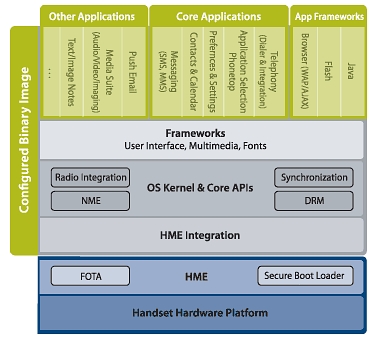Linux phone stack bonds with Android
Jan 14, 2008 — by Eric Brown — from the LinuxDevices Archive — 3 views A la Mobile demonstrated its Linux phone stack working with Google's Android APIs (application programming interfaces). The demonstration is intended to show how the Linux kernel, drivers, and middleware in a la Mobile's Convergent Linux Platform (CLP) can accelerate Android development, the company said.
A la Mobile demonstrated its Linux phone stack working with Google's Android APIs (application programming interfaces). The demonstration is intended to show how the Linux kernel, drivers, and middleware in a la Mobile's Convergent Linux Platform (CLP) can accelerate Android development, the company said.
(Click for larger view of HTC Qtek 9090 running CLP/Android)
The demonstration reportedly showed Android running on the Qtek 9090 smartphone. The phone is no longer actively marketed by HTC, but is still available, it appears.
The demo reportedly included about a dozen Android applications, some with GUI enhancements developed by A la Mobile. Applications featured in the demo included: browser, phone dialer, audio player, maps, camera, games, calendar, contacts manager, calculator, tasks manager, and notes.
Introduced in 2006, the CLP stack is touted as the only “complete” Linux-based mobile phone stack. It is said to include device drivers, a Linux 2.6.12 kernel, and middleware. There's also a suite of mobile applications based on Trolltech's Qtopia mobile phone application stack, a browser, and a security engine.
CLP's suite of pre-integrated, open-source and third-party applications include messaging, push-mail, VoIP, firmware over-the-air update, and as of last April, 3G multimedia streaming features, including Java and Adobe Flash. The company's strategic proprietary technology, though, is a hardware abstraction layer aimed at supporting rapid migration to new mobile phone hardware. A la Mobile likens this “Hardware Mobility Engine” (HME) to a “BIOS for mobile phones,” claiming that it allows a single software stack in binary form to easily move across different handsets and processors.

Convergent Linux Platform architecture
With its ready-to-go Linux phone stack, the company hopes to offer the mobile Linux community the same ease of porting as is commonly attributed to Windows Mobile. In this case, the demo appears to show how Android's upper level, Java-enabled framework and APIs can be easily integrated with CPE's kernel, drivers, middleware to create a “complete” Android software offering.
According to CEO Pauline Lo Alker, a la Mobile's technology and expertise can reduce development costs and trim a device's time-to-market by “at least half.” Stated Alker, “Despite the open-source nature of the Android framework, developing a complete mobile system solution with customized, differentiated features continues to present major technical challenges requiring considerable time, effort, and resources — a barrier and reach beyond the scope of many handset vendors.”
 Gupp Phreedom |
Customers to date for CPE include Gupp Technologies, a Malaysian startup. In October 2006, Gupp licensed the CLP stack for its Linux-based, dual-mode WiFi GSM/GPRS phone, the Gupp Phreedom (see photo at right).
The Android platform was developed by Google and supported by a group called the Open Handset Alliance (OHA). The alliance is hoping to establish the APIs as a de facto standard for upper-level, Java-based applications for Linux-based mobile phones. Over the last few weeks, several hardware devices have been hacked to run Android, and last week a hybrid GSM/VoWiFi phone prototype from Wistron NeWeb Corp. (WNC) showed up at CES, along with rumors that it's slated for a port to Android in the coming months.
This article was originally published on LinuxDevices.com and has been donated to the open source community by QuinStreet Inc. Please visit LinuxToday.com for up-to-date news and articles about Linux and open source.